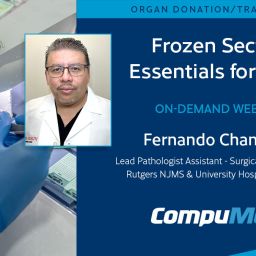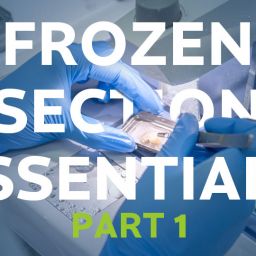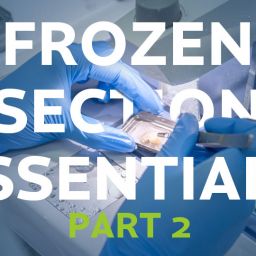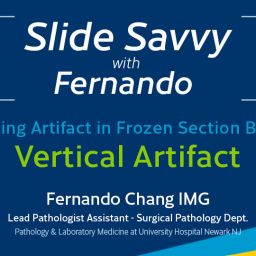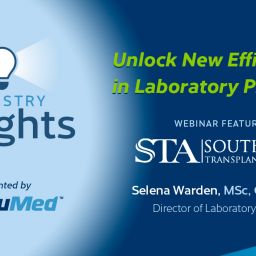Slide Savvy with Fernando
Frozen Section Troubleshooting & Tips
Frozen section, also known as cryosection, is significant in the field of organ donation and transplantation for its ability to help a transplant surgeon rapidly assess the health and viability of an organ for transplant. In our expert webinar series, Slide Savvy with Fernando, Fernando Chang, IMG, a pathologist assistant renowned for his expertise in frozen section analysis, shares tips to help OPOs minimize different types of artifact and make frozen section slides easier to read and interpret. The following blog contains excerpts from his presentation on Minimizing Freezing Artifact on Frozen Sections.
What is freezing artifact, and how can we identify it?
To minimize freezing artifact, we must first understand what it is and why it’s detrimental to an organ read. Freezing artifact is caused by ice crystals that disturb the tissue sample during the freezing process. Here’s an overview of four types of freezing artifact and how you can identify them.
Compression Artifact
- Bubbling artifact. As mentioned above, one type of freezing artifact is described as looking like Swiss cheese, with bubble-like spaces within the layers of the tissue.
- Compression artifact. One of the most frequent types of freezing artifact, compression artifact is characterized by a squeezed or squished appearance of the tissue’s tubules.
- Chromatin changes. Chromatin changes involve the alteration of the appearance of nuclear material, often making the chromatin (the substance within a cell nucleus) appear clumped or fragmented.
- Nuclear holes. Nuclear holes are observed as empty spaces within the nuclei, making them look hollow or incomplete.
How do I minimize freezing artifact?
The formation of ice crystals is the primary cause of freezing artifact. You can help prevent them by ensuring a rapid freezing process and using best practices for creating frozen section slides, such as: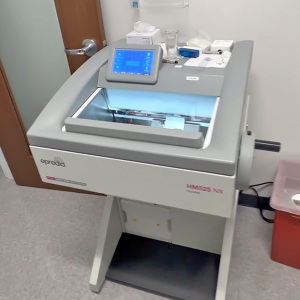
Cryostat
- Ensuring cryostat temperature is set to -24 degrees.
- Reaching the ideal cutting temperature, which is achieved when the block is between -17 and -18 degrees. Two ways to ensure proper cutting temperature include:
- Utilizing a temperature gun.
- Checking the color of the OCT (Optimal Cutting Temperature) compound, which should be a solid white. If the OCT media is gray in color, this is a reliable visual indicator that it hasn’t reached the ideal cutting temperature.
- Slicing tissue samples to 5 microns, the gold standard in thickness.
- Performing preventative maintenance on equipment and hardware at least every six months.
3 Tips for Troubleshooting
Experience and proper training can also help you become proficient at troubleshooting issues that lead to freezing artifact. Fernando offers three tips to help optimize your slide preparation techniques to minimize its occurrence.- Learn the differences between core biopsies and wedge biopsies.
Knowing what kind of tissue you’re looking at will help minimize freezing artifact. “Different organs have different water content, so if you are familiar with the water content of the tissue you’re dealing with, you can say whether the water content is going to be more than normal,” says Fernando.
- Pre-chill your OCT.
Pre-chilling your OCT (optimal cutting temperature) compound can also help minimize freezing artifact. Fernando recommends keeping OCT in a controlled environment, such as a nearby refrigerator set at 4 to 6 degrees. He says a refrigerator is preferable to the cryostat, as you may not know exactly when the tissue sample will arrive.
- Place well bars, chucks and heat extractors at the bottom of the cryostat.
Additionally, well bars, chucks and heat extractors should be placed at the bottom of the cryostat to stay at the lowest temperature possible. This is significant because the tissue sample will need to be frozen rapidly, and the longer the process takes, the more freezing artifact will appear in the section.
Focusing on these tips will help rapidly freeze the sample and minimize the amount of freezing artifact. As Fernando says, “You’ll get to the point that you’ll know when cutting a section, okay, this isn’t going to end well. You’ll start putting the dots together.” “It’s not just one reason or variable,” he adds. “Minimizing freezing artifact is something that comes with practice and observation.”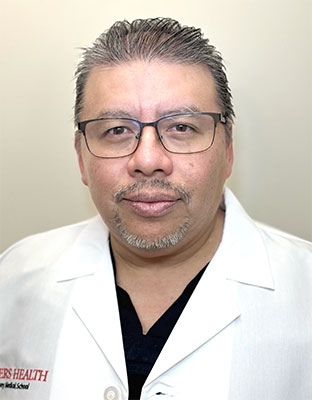
Fernando Chang IMG
Lead Pathologist Assistant – Surgical Pathology Department
Pathology and Laboratory Medicine at University Hospital Newark NJ
Rutgers Medical School
Summit Health
Atlantic Health Care System
RWJ Barnabas Healthcare system
Drawing from methodologies pioneered by the late Dr. Stephen Peters, Fernando collaborates with the Rutgers NJMS Pathology Residency program main surgical pathology and autopsy rotation at University Hospital. Here, he imparts innovative techniques in Anatomic Pathology Rotation, Frozen Sections, and the utilization of Telepathology Aperio Scan Scope. With more than 17 years of experience, Fernando has a wealth of expertise in working closely with OPOs.
More Resources for You
- For more tips and tricks for minimizing freezing artifact, watch this on-demand installment of Slide Savvy with Fernando, who presents real-life examples of freezing artifact beginning at the 7-minute mark of the webinar.
- Just starting out? In this webinar on Frozen Section Essentials, Fernando explains how it’s possible for OPO teams to set up a lab and produce quality donor-organ frozen sections.
- CompuMed’s biopsy reports are among the most comprehensive of any digital pathology team. Take a closer look at what’s included in our reports and how they give transplant centers the confidence to say yes to an organ faster.


